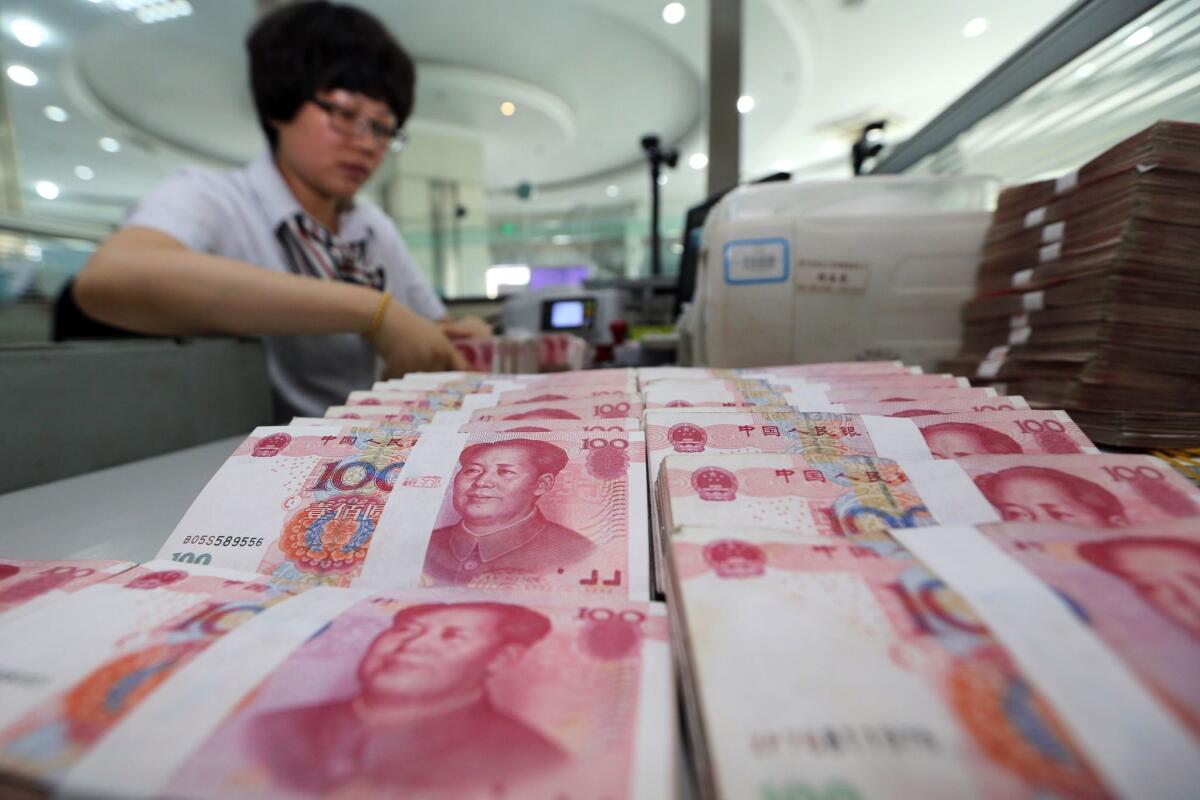President Trump weakens China’s currency, cries foul

- Share via
The Dow Jones industrial average went on a 900-point freefall Monday after China allowed its currency, the yuan, to weaken beyond the seven-to-a-dollar level it hasn’t breached since before the last recession. Traders had numerous reasons to freak out, but the overriding fear was that President Trump’s trade war was causing even more damage to the global economy.
So naturally, the Trump administration sought to deflect the blame. Late Monday afternoon, the Treasury Department designated China a currency manipulator, setting the stage for negotiations with the International Monetary Fund over what penalties to impose, if any.
China is a magnet for such accusations because the government dictates the value of the yuan, which isn’t freely traded the way other currencies are. Yet the value of the yuan still responds to market forces. And with China’s growth slowing and its exports to the U.S. sagging under the weight of the tariffs that Trump imposed, there’s simply not as much demand for the yuan as there used to be. That means the value of the yuan will head down unless the Chinese government uses the dollars it has collected (mainly from U.S. purchases of Chinese goods) to buy yuan, reducing the supply of yuan on the market and increasing the supply of dollars.
Andrew Kositkun, the head foreign exchange trader for City National Bank, said in an email that China had actually been working to slow the depreciation of its currency and keep it trading at less than seven to a dollar. So when the central government allowed the value to slide further Monday (that is, Monday here — it was Tuesday in China), that caught the market’s attention, Kositkun observed. It was especially noteworthy given the context: The move came a few days after Trump made the surprise threat to slap a 10% tariff on an additional $300 billion worth of Chinese consumer goods and other imports on Sept. 1. The threat came despite an agreement between the two countries to renew negotiations to end the current acrimony.
Put another way, Trump’s tariffs have weighed down the yuan, and the Chinese government decided to let the currency sink a bit. But this is a predictable consequence of the trade war the president launched. Tariffs can have a powerful effect on trade, but the effect diminishes over time because — absent government intervention — currency values adjust to the shift in prices and demand. There’s a dynamic equilibrium at work.
The Treasury Department’s announcement Monday appeared to recognize the inherent contradiction in accusing China of manipulation simply because it’s not doing enough to counter the effects of Trump’s tariffs. “China has a long history of facilitating an undervalued currency through protracted, large-scale intervention in the foreign exchange market,” the department stated Monday. “In recent days, China has taken concrete steps to devalue its currency, while maintaining substantial foreign exchange reserves despite active use of such tools in the past.”
Again, China invites these sorts of accusations because it has a fixed exchange rate, and in the past it has reduced the value of the yuan to promote its exports. In this case, though, the root of the problem is Trump administration trade policies.
There’s only so far China can allow the yuan to depreciate before causing a host of other problems. The fewer dollars the yuan buys, the harder it will be for Chinese borrowers to repay dollar-denominated debts; according to the Institute of International Finance, banks and private interests in the country have dollar-denominated debts equal to 5% to 6% of the country’s GDP. Still, just making the small move past seven yuan to the dollar was enough to break an important psychological threshold. Let’s all hope the drama ends there.
More to Read
Updates
9:34 a.m. Aug. 7, 2019: This piece was updated to identify the Institute of International Finance as the original source of the data on Chinese dollar-denominated debt.
A cure for the common opinion
Get thought-provoking perspectives with our weekly newsletter.
You may occasionally receive promotional content from the Los Angeles Times.







